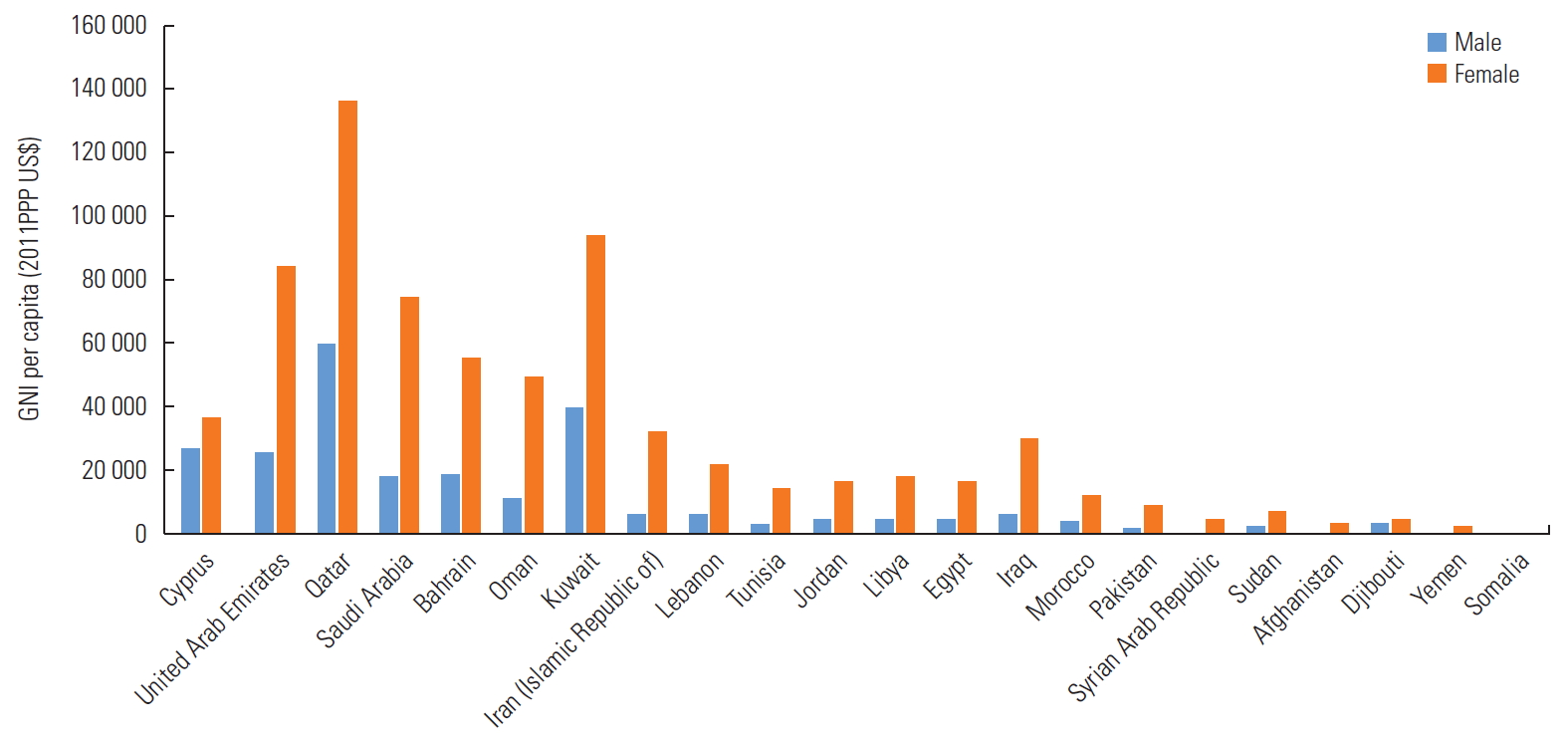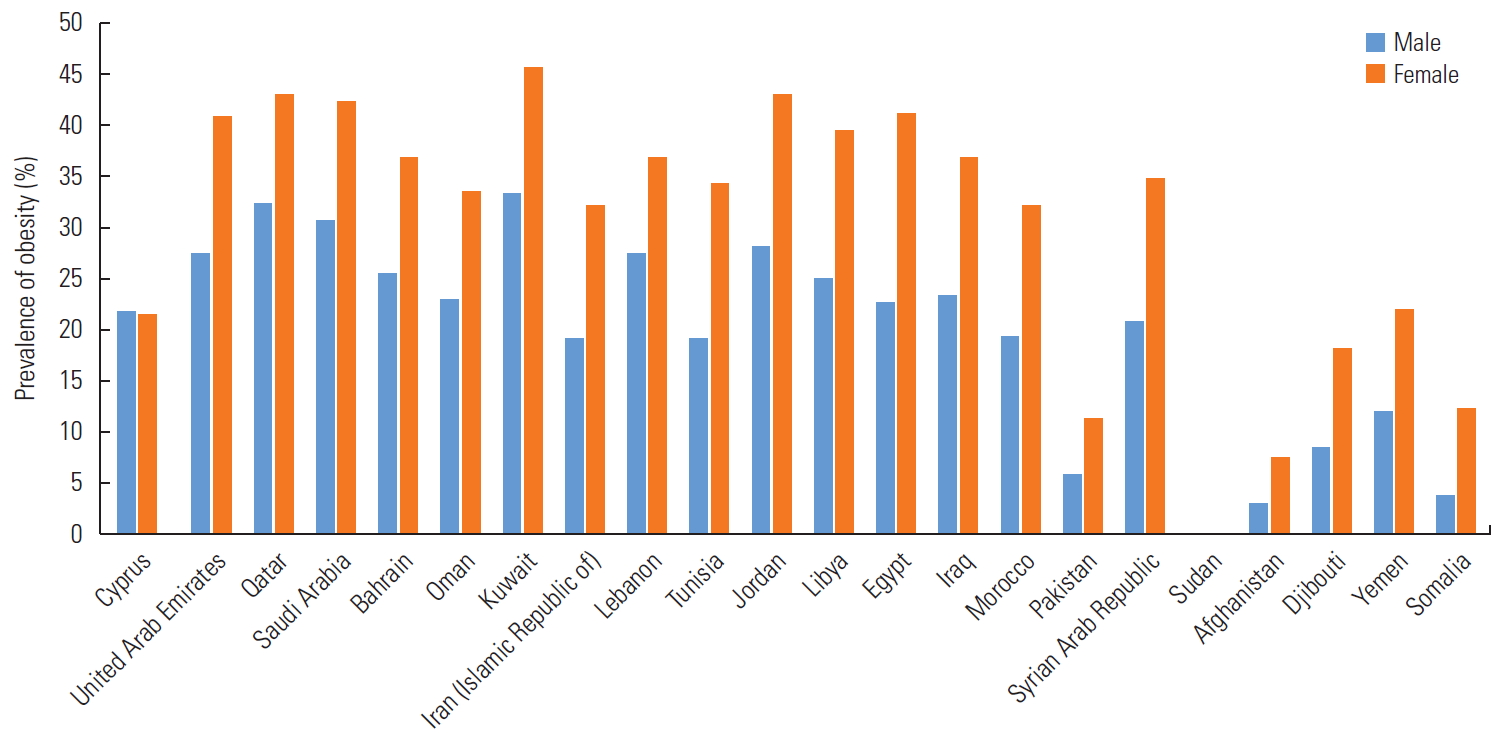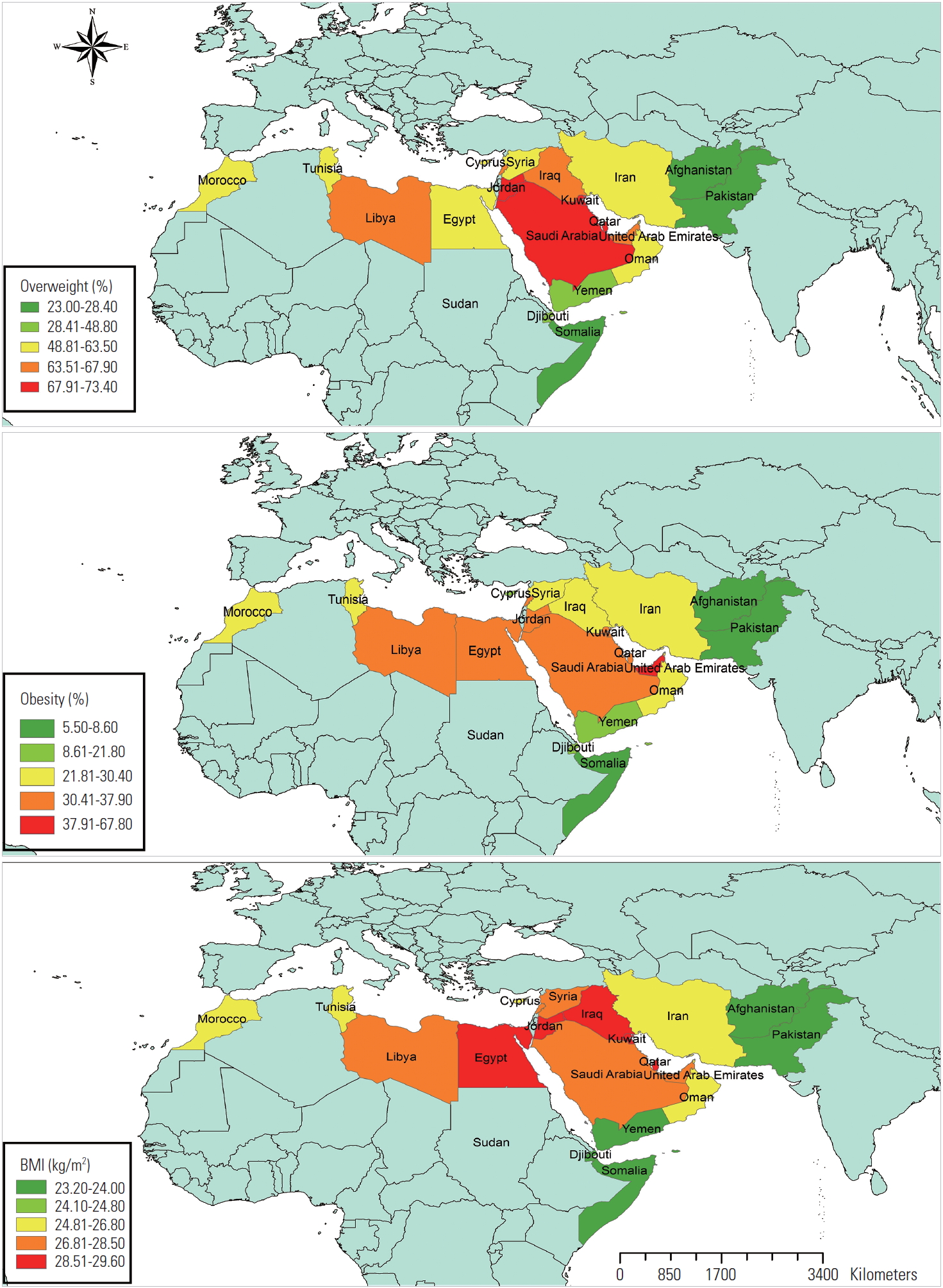Articles
- Page Path
- HOME > J Prev Med Public Health > Volume 53(2); 2020 > Article
-
Original Article
The Relationship Between Obesity, Overweight, and the Human Development Index in World Health Organization Eastern Mediterranean Region Countries -
Amin Ataey1
 , Elnaz Jafarvand2
, Elnaz Jafarvand2 , Davoud Adham3
, Davoud Adham3 , Eslam Moradi-Asl3
, Eslam Moradi-Asl3
-
Journal of Preventive Medicine and Public Health 2020;53(2):98-105.
DOI: https://doi.org/10.3961/jpmph.19.100
Published online: March 31, 2020
1Meshkin Shahr Health Center, Ardabil University of Medical Sciences, Ardabil, Iran
2Department of Community Nutrition, School of Nutritional Sciences and Dietetics, Tehran University of Medical Sciences, Tehran, Iran
3Department of Public Health, School of Public Health, Ardabil University of Medical Sciences, Ardabil, Iran
- Corresponding author: Eslam Moradi-Asl, PhD Department of Public Health, School of Health, Ardabil University of Medical Sciences, Daneshgah Street, Ardabil 5618953141, Iran E-mail: E.moradiasl@arums.ac.ir
• Received: April 30, 2019 • Accepted: December 27, 2019
Copyright © 2020 The Korean Society for Preventive Medicine
This is an Open Access article distributed under the terms of the Creative Commons Attribution Non-Commercial License (http://creativecommons.org/licenses/by-nc/4.0/) which permits unrestricted non-commercial use, distribution, and reproduction in any medium, provided the original work is properly cited.
Figure & Data
References
Citations
Citations to this article as recorded by 

- Identification and target of action of cholecystokinin‐releasing peptides from simulated digestion hydrolysate of wheat protein
Hongdong Song, Qingyu Wang, Zhuwei Shao, Xinyue Wang, Hongwei Cao, Kai Huang, Xiao Guan
Journal of the Science of Food and Agriculture.2024; 104(1): 295. CrossRef - Metabolically healthy/unhealthy obesity and breast cancer: A possible role of plasma-derived extracellular vesicles on the cancerous behavior of triple-negative breast cancer
Fataneh Esmaeili, Maryam Abolhasani, Hossein Zabihi-Mahmoudabadi, Shadi Sadat Seyyed Ebrahimi, Solaleh Emamgholipour, Maliheh Paknejad
Biochemical and Biophysical Research Communications.2024; 690: 149242. CrossRef - Stress, Anxiety, and Depression Before and Twelve Months After Bariatric Surgery: Repeated Cross-sectional Study
Amani ElBarazi
Indian Journal of Psychological Medicine.2024; 46(2): 159. CrossRef - Comparing Safety and Efficacy Outcomes of Gastric Bypass and Sleeve Gastrectomy in Patients With Type 2 Diabetes Mellitus: A Systematic Review and Meta-Analysis
Mohamed Elsaigh, Bakhtawar Awan, Ahmed Shabana , Azka Sohail, Ahmad Asqalan, Omnia Saleh, Justyna Szul, Rana Khalil, Hatem Elgohary, Mohamed Marzouk, Mohamed Alasmar
Cureus.2024;[Epub] CrossRef - The evaluation of bariatric surgery effect on cardiac structure and function using transthoracic echocardiography: a cohort study
Firoozeh Abtahi, Malek Atashbarg, Mahdi Rahmanian, Nader Moeinvaziri, Mehdi Bazrafshan, Hanieh Bazrafshan, Farzaneh Moammer, Helia Bazroodi, Abdolali Zolghadrasli, Hamed Bazrafshan drissi
BMC Surgery.2024;[Epub] CrossRef - Association of sex-specific body mass index and waist circumference trajectories with non-alcoholic fatty liver disease incidence based on growth mixture modeling
Tengrui Cao, Chao Tong, Qiang Li, Yumei Han, Aheyeerke Halengbieke, Xuetong Ni, Bo Gao, Deqiang Zheng, Xinghua Yang
Nutrition, Metabolism and Cardiovascular Diseases.2024; 34(5): 1245. CrossRef - Label-Free Electrochemical Immunosensor Based on Conjugated Polymer Film Coated Disposable Electrode for Ultrasensitive Determination of Resistin Potential Obesity Biomarker
Elif Burcu Aydın, Muhammet Aydın, Mustafa Kemal Sezgintürk
ACS Applied Bio Materials.2024; 7(3): 1820. CrossRef - What could be the reasons for not losing weight even after following a weight loss program?
Jyoti Dabas, S. Shunmukha Priya, Akshay Alawani, Praveen Budhrani
Journal of Health, Population and Nutrition.2024;[Epub] CrossRef - Global burden, risk factors, and trends of non‐Hodgkin lymphoma: A worldwide analysis of cancer registries
Junjie Huang, Sze Chai Chan, Veeleah Lok, Lin Zhang, Don Eliseo Lucero‐Prisno, Wanghong Xu, Zhi‐Jie Zheng, Edmar Elcarte, Mellissa Withers, Martin C. S. Wong
Cancer Medicine.2024;[Epub] CrossRef - Influence of Bariatric Surgery on Gut Microbiota Composition and Its Implication on Brain and Peripheral Targets
Sevag Hamamah, Andras Hajnal, Mihai Covasa
Nutrients.2024; 16(7): 1071. CrossRef - The melanocortin‐4 receptor pathway and the emergence of precision medicine in obesity management
Sima Fansa, Andres Acosta
Diabetes, Obesity and Metabolism.2024; 26(S2): 46. CrossRef - The New Challenge of Obesity - Obesity-Associated Nephropathy
Mengjin Hao, You Lv, Siyuan Liu, Weiying Guo
Diabetes, Metabolic Syndrome and Obesity.2024; Volume 17: 1957. CrossRef - Mid-range theory of the nursing diagnosis Overweight
Ana Carolina Costa Carino, Renata Marinho Fernandes, Anna Thays Dias Almeida, Cecília Maria Farias de Queiroz Frazão, Caroline Evelin Nascimento Kluczynik, Ana Luisa Brandão de Carvalho Lira
Revista Brasileira de Enfermagem.2024;[Epub] CrossRef - 3D Reconstruction and Virtual Reality Is an Acceptable and Feasible Method for Addressing Body Image in Bariatric Metabolic Surgery
Nazrin Assaf, Samantha Scholtz, Ahmed R. Ahmed, Mitchel Krieger, Nasteha Ali, Fernando Bello
Obesity Surgery.2024; 34(7): 2711. CrossRef - Meta-analysis of the Impact of Bariatric Surgery on Circulating
TMAO Levels as a Predictor of Cardiovascular Disease Risk
Tannaz Jamialahmadi, Luis E. Simental-Mendia, Gokhan Zengin, Wael Almahmeed, Prashant Kesharwani, Amirhossein Sahebkar
Current Medicinal Chemistry.2024; 31(24): 3791. CrossRef - Genetic Deletion of DNAJB3 Using CRISPR-Cas9, Produced Discordant Phenotypes
Shadi Nejat, Kalhara R. Menikdiwela, Aliyah Efotte, Shane Scoggin, Bolormaa Vandanmagsar, Paul J. Thornalley, Mohammed Dehbi, Naima Moustaid-Moussa
Genes.2023; 14(10): 1857. CrossRef - Sweet Taste Receptors and Associated Sweet Peptides: Insights into Structure and Function
Shulei Zhao, Hanyuan Zheng, Yujia Lu, Na Zhang, Olugbenga P. Soladoye, Yuhao Zhang, Yu Fu
Journal of Agricultural and Food Chemistry.2023; 71(38): 13950. CrossRef - Uncovering the pathogenesis of obesity complicated with papillary thyroid carcinoma via bioinformatics and experimental validation
Kaisheng Yuan, Di Hu, Xiaocong Mo, Ruiqi Zeng, Bing Wu, Zunhao Zhang, Ruixiang Hu, Cunchuan Wang
Aging.2023; 15(17): 8729. CrossRef - Profiling of potential pathogenic candida species in obesity
Mehreen Shoukat, Faheem Ullah, Marbaila Nane Tariq, Ghufranud Din, Bibi Khadija, Rani Faryal
Microbial Pathogenesis.2023; 174: 105894. CrossRef - Underweight, overweight, obesity and associated factors among elementary school children: A cross-sectional study in Kerman province, Iran
Mojgan Sanjari, Ladan Amirkhosravi, Seyed Ehsan Hosseini, Mahzad tavakolinejad kermani, Farzaneh Abdollahi, Atefeh Maghfoori, Mostafa Eghbalian
Obesity Medicine.2023; 38: 100477. CrossRef - Long-Term High-Fat Diet Consumption Induces Cognitive Decline Accompanied by Tau Hyper-Phosphorylation and Microglial Activation in Aging
Zheng Liang, Xiaokang Gong, Runjia Ye, Yang Zhao, Jin Yu, Yanna Zhao, Jian Bao
Nutrients.2023; 15(1): 250. CrossRef - Association of pro-inflammatory cytokines, inflammatory proteins with atherosclerosis index in obese male subjects
Farhad Alizadeh, Fariba Mirzaie Bavil, Rana Keyhanmanesh, Hajie Lotfi, Fariba Ghiasi
Hormone Molecular Biology and Clinical Investigation.2023; 44(2): 121. CrossRef - The effect of obesity on chronic diseases in USA: a flexible copula approach
Robinson Dettoni, Cliff Bahamondes, Carlos Yevenes, Cristian Cespedes, Javier Espinosa
Scientific Reports.2023;[Epub] CrossRef - The role of gender inequality and health expenditure on the coverage of demand for family planning satisfied by modern contraceptives: a multilevel analysis of cross-sectional studies in 14 LAC countries
Laísa Rodrigues Moreira, Cauane Blumenberg, Beatriz Elena Caicedo Velasquez, Fernanda Ewerling, Alejandra Balandrán, Luis Paulo Vidaletti, Andrea Ramirez Varela, Franciele Hellwig, Rodolfo Gomez Ponce de Leon, Aluisio J.D. Barros, Mariangela Freitas Silve
The Lancet Regional Health - Americas.2023; 19: 100435. CrossRef - Participatory evaluation of municipal obesity prevention clubs in Tehran city: Strengths, challenges, and future direction
Sareh Edalati, Nasrin Omidvar, Amirhossein Takian, Farzaneh Rasam, Delaram Ghodsi, Reza Majdzadeh
Frontiers in Public Health.2023;[Epub] CrossRef - Efficacy of traditional Chinese exercise for obesity: A systematic review and meta-analysis
Ze Yang, Kai Huang, Yang Yang, Qike Xu, Qiaofeng Guo, Xiang Wang
Frontiers in Endocrinology.2023;[Epub] CrossRef - Examining the Effects of Human Development, Unemployment, and Globalization on Obesity in the Community: Evidence from BRICS Countries
Mucahit Aydin, Mehmet Aydin, Daniel Diaz
Health & Social Care in the Community.2023; 2023: 1. CrossRef - Efficacy of traditional Chinese exercises in improving anthropometric and biochemical indicators in overweight and obese subjects: A systematic review and meta-analysis
Qianfang Yang, Fan Wang, Limin Pan, Ting Ye
Medicine.2023; 102(12): e33051. CrossRef - Global and national prevalence of nonalcoholic fatty liver disease in adolescents: An analysis of the global burden of disease study 2019
Phillipp Hartmann, Xinlian Zhang, Rohit Loomba, Bernd Schnabl
Hepatology.2023; 78(4): 1168. CrossRef - State of art on the mechanisms of laparoscopic sleeve gastrectomy in treating type 2 diabetes mellitus
Fa-Shun Liu, Song Wang, Xian-Shan Guo, Zhen-Xiong Ye, Hong-Ya Zhang, Zhen Li
World Journal of Diabetes.2023; 14(6): 632. CrossRef - Impact of obesity on catheter ablation of atrial fibrillation: Patient characteristics, procedural complications, outcomes, and quality of life
Chadi Tabaja, Arwa Younis, Pasquale Santageli, Medhat Farwati, Lorenzo Braghieri, Hiroshi Nakagawa, Walid I. Saliba, Ruth Madden, Patricia Bouscher, Mohamed Kanj, Thomas D. Callahan, David Martin, Mandeep Bhargava, Mina Chung, Bryan Baranowski, Shady Nakh
Journal of Cardiovascular Electrophysiology.2023; 34(8): 1648. CrossRef - The missing middle of childhood
Maj-Lis Voss, Mariam Claeson, Sven Bremberg, Stefan Swartling Peterson, Tobias Alfvén, Grace Ndeezi
Global Health Action.2023;[Epub] CrossRef - Dietary Fat Modulation of Gut Microbiota and Impact on Regulatory Pathways Controlling Food Intake
Sevag Hamamah, Arman Amin, Abdul Latif Al-Kassir, Judith Chuang, Mihai Covasa
Nutrients.2023; 15(15): 3365. CrossRef - Bariatric Surgery Reduces Weight Loss, Comorbidities Prevalence, and Improves Quality of Life in the Southern Region of Saudi Arabia
Abdulaziz A. Arishi, Ibrahim Metaan Gosadi, Ibrahim Ali Hakami, Hussam Darraj, Faisal Abusageah, Khalid M. Hakami, Shaden A. Zaalah, Mohammed Awaf, Rawan Maghrabi, Afnan A. Alamer, Sulaiman Hamdi, Mohammad Abdu Jareebi, Amro M. Masmali, Ghalia H. Hakami,
Medicina.2023; 59(10): 1695. CrossRef - The combined effects of exposure to multiple PM2.5 components on overweight and obesity in middle-aged and older adults: a nationwide cohort study from 125 cities in China
Xue Li, Yueyang Wu, Guoao Li, Wenbin Shen, Wei Xiao, Jianjun Liu, Wenlei Hu, Huanhuan Lu, Fen Huang
Environmental Geochemistry and Health.2023; 45(11): 8749. CrossRef - Financial inclusion and inclusive growth in Africa: What is the moderation role of financial stability?
Khadijah Iddrisu, James N. Doku, Joshua Y. Abor, Raymond Dziwornu
Cogent Economics & Finance.2023;[Epub] CrossRef - Chromatographic Analyses of Spirulina (Arthrospira platensis) and Mechanism of Its Protective Effects against Experimental Obesity and Hepatic Steatosis in Rats
Fatma Arrari, Mohamed-Amine Jabri, Ala Ayari, Nouha Dakhli, Chayma Ben Fayala, Samir Boubaker, Hichem Sebai
Medicina.2023; 59(10): 1823. CrossRef - Factors Involved in the Evolution of the Basal Metabolic Rate over 30 Months After Roux-en-Y Gastric Bypass
Michelle T. F. Reichmann, Alexia Duarte, Flavio Ivano, Antonio Carlos L. Campos
Obesity Surgery.2023; 33(11): 3494. CrossRef - lncRNA MSTRG4710 Promotes the Proliferation and Differentiation of Preadipocytes through miR-29b-3p/IGF1 Axis
Tao Tang, Genglong Jiang, Jiahao Shao, Meigui Wang, Xiaoxiao Zhang, Siqi Xia, Wenqiang Sun, Xianbo Jia, Jie Wang, Songjia Lai
International Journal of Molecular Sciences.2023; 24(21): 15715. CrossRef - Plant Secondary Compounds Promote White Adipose Tissue Browning via Modulation of the Gut Microbiota in Small Mammals
Shien Ren, Liangzhi Zhang, Xianjiang Tang, Chao Fan, Yaqi Zhao, Qi Cheng, Yanming Zhang
International Journal of Molecular Sciences.2023; 24(24): 17420. CrossRef - Nutrition and cellular senescence in obesity-related disorders
Teresa Rubio-Tomás, Ascensión Rueda-Robles, Julio Plaza-Díaz, Ana I. Álvarez-Mercado
The Journal of Nutritional Biochemistry.2022; 99: 108861. CrossRef - Development of a nutrition management software based on selected Middle Eastern and Mediterranean dishes to support personalized diet and weight management
Muhammad H. Alu'datt, Yaser Khamayseh, Mohammad N. Alhamad, Carole C. Tranchant, Sana Gammoh, Taha Rababah, Stan Kubow, Soudade S. Al Obaidy, Mohammad Alrosan, Haya Alzoubi, Thuan-Chew Tan
Food Chemistry.2022; 373: 131531. CrossRef - Pyrethroids exposure induces obesity and cardiometabolic diseases in a sex-different manner
Lei Zuo, Li Chen, Xia Chen, Mingliang Liu, Haiyan Chen, Guang Hao
Chemosphere.2022; 291: 132935. CrossRef - Dipeptidyl peptidase IV inhibition delays developmental programming of obesity and metabolic disease in male offspring of obese mothers
Kim Ramil C. Montaniel, Matthew Bucher, Elysse A. Phillips, Cun Li, Elinor L. Sullivan, Paul Kievit, Sandra Rugonyi, Peter W. Nathanielsz, Alina Maloyan
Journal of Developmental Origins of Health and Disease.2022; 13(6): 727. CrossRef - Tuina combined with diet and exercise for simple obesity
Lili Chen, Deyu Cong, Gaofeng Wang, Jiabao Sun, Yuanyuan Ji, Zhen Zhong, Tong Liu, Jiayi Liu, Yunjie Chu, Xingquan Wu
Medicine.2022; 101(6): e28833. CrossRef - Binary Effects of Gynostemma Gold Nanoparticles on Obesity and Inflammation via Downregulation of PPARγ/CEPBα and TNF-α Gene Expression
Reshmi Akter, Li Ling, Esrat Jahan Rupa, Jin KyuPark, Ramya Mathiyalagan, Jinnatun Nahar, Lee Jong Won, Kim Do Hyun, Mohanapriya Murugesan, Deok Chun Yang, Se Chan Kang, Gi-Young Kwak
Molecules.2022; 27(9): 2795. CrossRef - Inequalities in overweight and obesity among reproductive age group women in India: evidence from National Family Health Survey (2015–16)
Pradeep Kumar, Sherry Mangla, Sampurna Kundu
BMC Women's Health.2022;[Epub] CrossRef - Associations of self-reported residential noise exposure with obesity and hypertension in children and adolescents
Xiaohua Liang, Xian Tang, Mingliang Liu, Xiaoyue Liang, Li Chen, Xia Chen, Lei Zuo, Yanling Ren, Guang Hao
Frontiers in Pediatrics.2022;[Epub] CrossRef - Lipotoxicity as a Barrier for T Cell-Based Therapies
Romy Böttcher-Loschinski, Judit Rial Saborido, Martin Böttcher, Sascha Kahlfuss, Dimitrios Mougiakakos
Biomolecules.2022; 12(9): 1182. CrossRef - Asparagus cochinchinensis alleviates disturbances of lipid metabolism and gut microbiota in high-fat diet-induced obesity mice
Shiyue Luo, Lixiao Zhou, Xuejun Jiang, Yinyin Xia, Lishuang Huang, Run Ling, Shixin Tang, Zhen Zou, Chengzhi Chen, Jingfu Qiu
Frontiers in Pharmacology.2022;[Epub] CrossRef - Advances in multi-omics study of biomarkers of glycolipid metabolism disorder
Xinyi Fang, Runyu Miao, Jiahua Wei, Haoran Wu, Jiaxing Tian
Computational and Structural Biotechnology Journal.2022; 20: 5935. CrossRef - Effects of different weight loss programmes on oncological outcomes following curative resection of digestive tract cancers
Osamah S Niaz, Max Seabrook, Talha Niaz, Irfan Ahmed, Rebecca Parrott, Ahsan Rao
Cochrane Database of Systematic Reviews.2022;[Epub] CrossRef - Organokines, Sarcopenia, and Metabolic Repercussions: The Vicious Cycle and the Interplay with Exercise
Giulia Minniti, Letícia Maria Pescinini-Salzedas, Guilherme Almeida dos Santos Minniti, Lucas Fornari Laurindo, Sandra Maria Barbalho, Renata Vargas Sinatora, Lance Alan Sloan, Rafael Santos de Argollo Haber, Adriano Cressoni Araújo, Karina Quesada, Jesse
International Journal of Molecular Sciences.2022; 23(21): 13452. CrossRef - Unhealthy food environments that promote overweight and food insecurity in a brazilian metropolitan area: A case of a syndemic?
Juliana Souza Oliveira, Risia Cristina Egito de Menezes, Ricardo Almendra, Pedro Israel Cabral de Lira, Nathália Barbosa de Aquino, Nathália Paula de Souza, Paula Santana
Food Policy.2022; 112: 102375. CrossRef - Ephedra alata subsp. alenda (Ephedraceae) leaf extracts: phytochemical screening, anti-diabetic, anti-obesity and anti-toxic activities on diabetic-induced liver-kidney-testes toxicities and inhibition of α-amylase and lipase enzymes
Saber Abdelkader Saidi, Turki M. Al-Shaikh, Othman A. Alghamdi, Khaled Hamden
Heliyon.2022; 8(12): e11954. CrossRef - Multidisciplinary Progress in Obesity Research
Xiaoqing Lu, Yuxin Jin, Dexin Li, Jingxin Zhang, Jingyan Han, Yin Li
Genes.2022; 13(10): 1772. CrossRef - Comparing acupoint catgut embedding and acupuncture therapies for simple obesity: A systematic review and meta-analysis
Hui Yan Zhao, Sungha Kim, Mi Ju Son
Medicine.2022; 101(51): e31531. CrossRef - Prevalence of Chronic Kidney Disease Among Diabetes and Hypertensive Patients in a Teaching Hospital in Ekiti State, Southwest Nigeria
Oluwaseyi A. Akpor, Abigael O. Adeoye, Funmilayo A. Ibitoba, Oghenerobor B. Akpor
The Open Public Health Journal.2022;[Epub] CrossRef - Role of Advanced Tools and Technologies (M-Health Apps & Fitness Watches) in Affecting the Nutritional Wellness and Lifestyle Behaviors of University Students
Taiba Tanvir, Maira Iftikhar, Komal Sajjad, Roman Ali
DIET FACTOR (Journal of Nutritional & Food Sciences).2022; : 28. CrossRef - Diabetes and Cancer: Metabolic Association, Therapeutic Challenges, and the Role of Natural Products
Wamidh H. Talib, Asma Ismail Mahmod, Sara Feras. Abuarab, Eliza Hasen, Amer A. Munaim, Shatha Khaled Haif, Amani Marwan Ayyash, Samar Khater, Intisar Hadi AL-Yasari, Lina T. Al Kury
Molecules.2021; 26(8): 2179. CrossRef - Child behavior during the social distancing in the COVID-19 pandemic
Eny Dórea Paiva, Luciana Rodrigues da Silva, Maria Estela Diniz Machado, Rosane Cordeiro Burla de Aguiar, Karina Rangel da Silva Garcia, Paloma Gonçalves Martins Acioly
Revista Brasileira de Enfermagem.2021;[Epub] CrossRef - Peripheral Blood Mononuclear Cells Oxidative Stress and Plasma Inflammatory Biomarkers in Adults with Normal Weight, Overweight and Obesity
Margalida Monserrat-Mesquida, Magdalena Quetglas-Llabrés, Cristina Bouzas, Xavier Capó, David Mateos, Lucía Ugarriza, Josep A. Tur, Antoni Sureda
Antioxidants.2021; 10(5): 813. CrossRef - Socioeconomic disparity in global vision loss burden due to diabetic retinopathy: an analysis on time trends from 1990 to 2017
Yi Shan, Yufeng Xu, Lingxia Ye, Xiling Lin, Yaoyao Chen, Qi Miao, Juan Ye
Endocrine.2021; 73(2): 316. CrossRef - The Prevalence of Overweight and Obesity Among Women in Jordan: A Risk Factor for Developing Chronic Diseases
Mona Bustami, Khalid Z Matalka, Eyad Mallah, Luay Abu-Qatouseh, Wael Abu Dayyih, Nour Hussein, Nayef Abu Safieh, Yousef Elyyan, Nagham Hussein, Tawfiq Arafat
Journal of Multidisciplinary Healthcare.2021; Volume 14: 1533. CrossRef - Saudi Arabia’s Healthy Food Strategy: Progress & Hurdles in the 2030 Road
Faisal Fahad Bin Sunaid, Ayoub Al-Jawaldeh, Meshal Wasel Almutairi, Rawan Abdulaziz Alobaid, Tagreed Mohammad Alfuraih, Faisal Naser Bensaidan, Atheer Shayea Alragea, Lulu Ali Almutairi, Ali F. Duhaim, Talal Ali Alsaloom, Jana Jabbour
Nutrients.2021; 13(7): 2130. CrossRef - Ginsenoside F2 Suppresses Adipogenesis in 3T3-L1 Cells and Obesity in Mice via the AMPK Pathway
Jing Zhou, Ji Zhang, Jiayi Li, Yiqiu Guan, Ting Shen, Fu Li, Xueqin Li, Xiaojun Yang, Weicheng Hu
Journal of Agricultural and Food Chemistry.2021; 69(32): 9299. CrossRef - A systematic literature review on obesity: Understanding the causes & consequences of obesity and reviewing various machine learning approaches used to predict obesity
Mahmood Safaei, Elankovan A. Sundararajan, Maha Driss, Wadii Boulila, Azrulhizam Shapi'i
Computers in Biology and Medicine.2021; 136: 104754. CrossRef - Direct Endoplasmic Reticulum Targeting by the Selective Alkylphospholipid Analog and Antitumor Ether Lipid Edelfosine as a Therapeutic Approach in Pancreatic Cancer
Faustino Mollinedo, Consuelo Gajate
Cancers.2021; 13(16): 4173. CrossRef - Elucidating the Macroeconomic Determinants of Undernourishment in South Asian Countries: Building the Framework for Action
Noshaba Aziz, Jun He, Ali Raza, Hongguang Sui, Wang Yue
Frontiers in Public Health.2021;[Epub] CrossRef - Obesity: Epidemiology, Pathophysiology, and Therapeutics
Xihua Lin, Hong Li
Frontiers in Endocrinology.2021;[Epub] CrossRef - Health benefits and phenolic compounds of Moringa oleifera leaves: A comprehensive review
Mohamed Ahmed Hassan, Tao Xu, Yang Tian, Yongheng Zhong, Fatma Abo Zakaib Ali, Xuan Yang, Baiyi Lu
Phytomedicine.2021; 93: 153771. CrossRef - Undernourishment trends and determinants: an ecological study of 76 countries
H. Eini-Zinab, S. Edalati, S.R. Sobhani, M.F. Kezabi, S. Hosseini
Public Health.2020; 186: 230. CrossRef
 KSPM
KSPM




 PubReader
PubReader ePub Link
ePub Link Cite
Cite




